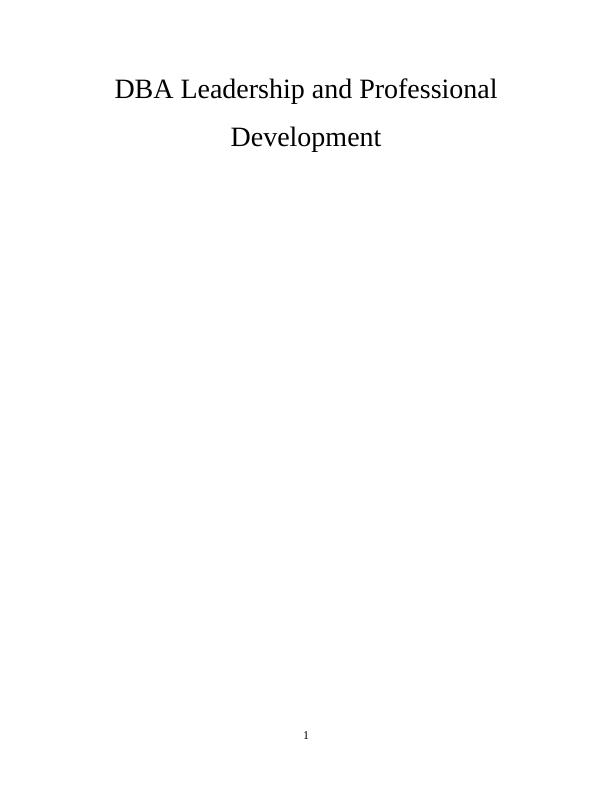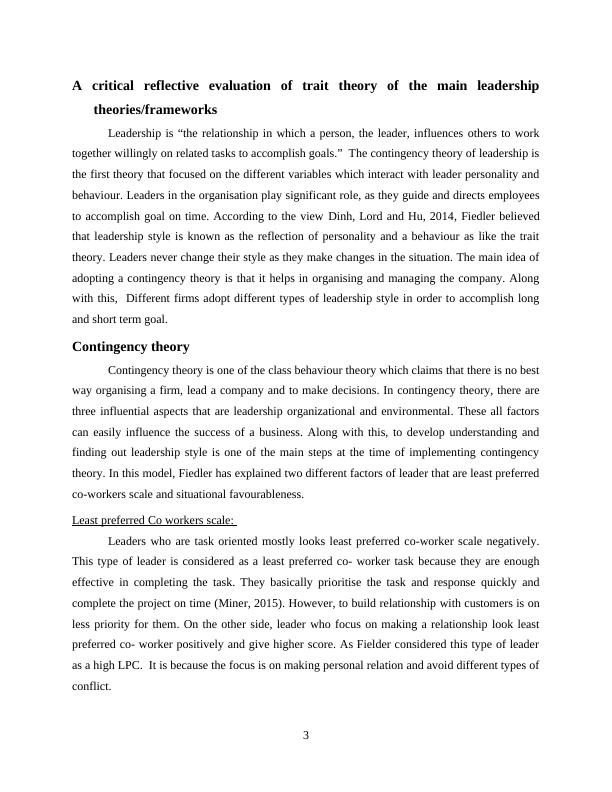DBA Leadership and Professional Development
Added on 2020-06-03
14 Pages5078 Words103 Views
DBA Leadership and ProfessionalDevelopment1

Table of ContentsA critical reflective evaluation of trait theory of the main leadership theories/frameworks...........3Contingency theory..........................................................................................................................3Least preferred Co workers scale:..........................................................................................3Situational favourableness......................................................................................................4Situational Leadership Model..........................................................................................................4Advantage and disadvantage..................................................................................................4Path goal theory...............................................................................................................................6Characteristics........................................................................................................................6Directive leadership style:................................................................................................................8Advantage and disadvantage..................................................................................................8Trait theory of leadership...............................................................................................................10Reflection.......................................................................................................................................11Reference.......................................................................................................................................132

A critical reflective evaluation of trait theory of the main leadershiptheories/frameworksLeadership is “the relationship in which a person, the leader, influences others to worktogether willingly on related tasks to accomplish goals.” The contingency theory of leadership isthe first theory that focused on the different variables which interact with leader personality andbehaviour. Leaders in the organisation play significant role, as they guide and directs employeesto accomplish goal on time. According to the view Dinh, Lord and Hu, 2014, Fiedler believedthat leadership style is known as the reflection of personality and a behaviour as like the traittheory. Leaders never change their style as they make changes in the situation. The main idea ofadopting a contingency theory is that it helps in organising and managing the company. Alongwith this, Different firms adopt different types of leadership style in order to accomplish longand short term goal. Contingency theoryContingency theory is one of the class behaviour theory which claims that there is no bestway organising a firm, lead a company and to make decisions. In contingency theory, there arethree influential aspects that are leadership organizational and environmental. These all factorscan easily influence the success of a business. Along with this, to develop understanding andfinding out leadership style is one of the main steps at the time of implementing contingencytheory. In this model, Fiedler has explained two different factors of leader that are least preferredco-workers scale and situational favourableness. Least preferred Co workers scale: Leaders who are task oriented mostly looks least preferred co-worker scale negatively.This type of leader is considered as a least preferred co- worker task because they are enougheffective in completing the task. They basically prioritise the task and response quickly andcomplete the project on time (Miner, 2015). However, to build relationship with customers is onless priority for them. On the other side, leader who focus on making a relationship look leastpreferred co- worker positively and give higher score. As Fielder considered this type of leaderas a high LPC. It is because the focus is on making personal relation and avoid different types ofconflict. 3

Situational favourablenessIn the Situational favourableness there are three factors considered which are as follows:Task structure: It mainly shows the nature of the task which is performed by a leader. Thestructure can be vague or clear it is required to be complete on time. However, if the leader hasless knowledge related to the task then it shows that unfavorable leadership situation.Leader-member relation: It shows the relationship between leader and team members. Level oftrust that team member has on the leader and the way leader influence the group of members towork in a difficult situation (McCleskey, 2014).Leaders positional power: It is considered a position of leader for leading and directing the teammember. When more power leader has then there may be more favorable situation for a leader. There are different models considered in the contingency leadership theory that are as follows:Situational Leadership Model Situational leadership is known as the model of leadership that can be considered underthe contingency theory of leadership. As other theories such as path goal leaders are not variablebecause they are related to the follower maturity (Breevaart, Bakker and Derks, 2016). Usingsituational leadership style, it can become easy to understand which of the four-leadership stylecan be used in different situation to accomplish goal. Advantage and disadvantage Telling (S1)- In this leadership style leaders make the decision itself and communicatewith other team members (Van Wart, 2014). The leader delegate all the task creates theroles and objectives which is needed to be accepted by others. Hence in thiscommunication is basically one way and it is effective to get the repetitive style.Selling: In these leaders create roles and responsibilities for followers and like to takeviews and opinion of their team member. All the ideas are sold to others for gainingcooperation. Hence, this style involves more back and forth among the team member andleader. A specific instruction is provided from the side of team leader and they monitorthe performance. Leader spends equal time with team member in respect to support anddirect them (Lord, Day and Eagly, 2017). A leader can also consult with a team memberif it faces it face difficulty in making decision. On the other side, leader supports its teammember and states the reason for performing the task. 4

End of preview
Want to access all the pages? Upload your documents or become a member.
Related Documents
(PDF) Sales Management Assignmentlg...
|14
|3415
|40
Leadership - A Critical Perspectivelg...
|12
|2659
|276
Fiedler's Contingency Theorylg...
|10
|3788
|75
Leadership Theories at different Wokplace Situations : Reportlg...
|5
|1218
|155
Definition of Leadership 1 Definition of Leadership 1 LEADERSHIP & PROESSIONAL DEVELOPMENT CONTENTS INTRODUCTION 1 Definition of Leadership 1 LEADERSHIP & PROESSIONAL DEVELOPMENT CONTENTS Interruptionlg...
|19
|5733
|446
Report on Organizational Behavior Samplelg...
|1
|1983
|131
